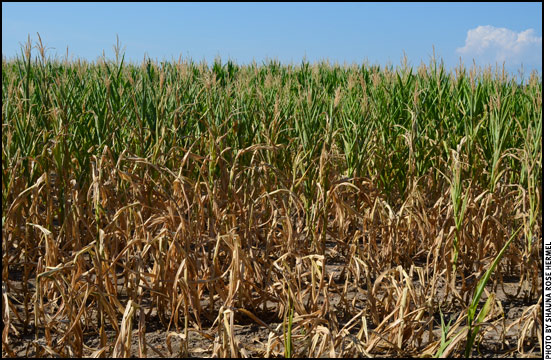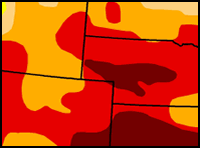HEALTH & NUTRITION...

Drought Conditions Make Corn Dangerous to Feed to Livestock
MU expert says high nitrate levels in corn can cause miscarriage, sudden death for animals.
As the hot summer and severe drought continues across much of the Midwest, thousands of farmers are being forced to abandon ruined corn crops. With much of the year's corn crop expected to yield much less grain than anticipated, many farmers are left to harvest their fields early to salvage what nutritional value they can to feed their animals, especially cattle. Tim Evans, an associate professor of veterinary pathobiology and toxicology section head at the Veterinary Medical Diagnostic Laboratory at the University of Missouri (MU) College of Veterinary Medicine, warns farmers and livestock producers that drought-damaged corn plants can pose a risk to animal health. Read more.
Emerging Health Research, Issues
New viruses, alternate weaning strategies and new thoughts on pulmonary hypertension in cattle were all topics of discussion at the National Cattlemen's Beef Association (NCBA) Emerging Health Research and Issues Working Group. Read more.

Rick Rasby
Ridin’ Herd
Interesting times in the beef industry: Part II
Mother Nature seems to have a stranglehold on many areas of the United States where beef cows reside. Little to no precipitation in areas that grow corn and soybeans has resulted in record-high prices in both of those commodities. As the price of corn goes up, the price of other feedstuffs we feed our cattle goes up, as well. Read more.
A New Line of Defense
Researchers find cattle vaccine works to reduce E. coli O157:H7 in a large-scale feedlot setting.
A commercial vaccine for cattle can effectively reduce levels of E. coli by more than 50%, a Kansas State University (K-State) study has found. The vaccine is also effective using two doses instead of the recommended three doses, which can help cut costs for the beef industry. Read more.
 Preconditioning Strategies For Drought-Stricken Areas
Preconditioning Strategies For Drought-Stricken Areas
Drought conditions offer unique challenges for preconditioning this year.
The U.S. Drought Monitor continues to show the spread of severe and extreme drought into larger areas of cow-calf country. Producers are seeing the effects of more heat, reduced forage quality and dwindling water supplies in the cows and calves. Read more.
Know the Basics of Strategic Deworming
Keeping a healthy herd requires proper planning.
A strategic deworming approach involves more than administering a dewormer annually. It's about knowing when parasites could be compromising the health of your cattle.
"Timing is critical for strategic deworming programs," says Gary Sides, cattle nutritionist, Pfizer Animal Health cattle and equine technical services. "Along with timing, selecting the appropriate active ingredient, using proper administration techniques and even taking geography into consideration are all vital parts of getting the most out of your deworming program."
A strategic program aims to interrupt the life cycle of the parasite. To do that, cattle producers should deworm their herd twice a year — once in the spring at the beginning of grass green-up and again in the fall before winter turnout. Read more.
Three Steps To Winning The Battle Against BRD
Respiratory vaccination tips can help keep cattle healthy and productive.
For cattle producers, half the battle to keep cattle healthy is choosing the right vaccine to help prevent bovine respiratory disease (BRD).
BRD is the leading cause of economic loss in the beef industry, with losses of up to $240 per head.1,2 Cattle that never develop BRD are more productive and less costly than those treated for the disease. For that reason, it pays to help prevent the most frequent causes of BRD with a complete vaccination program.
There are many causes and complexities of BRD, but viral infections and stress typically are involved. Minimizing stress and the use of a vaccine that helps prevent common bovine respiratory pathogens, such as infectious bovine rhinotracheitis (IBR), bovine viral diarrhea (BVD) Types 1 and 2, bovine respiratory syncytial virus (BRSV) and parainfluenza 3 (PI3), are key to helping prevent BRD and its associated production losses and treatment costs. Read more.
Cattle Diseases: Common Conditions/Terms
Click here for a list of common conditions and terms related to beef cattle diseases, such as anaplasmosis, brucellosis, BVD, E. coli, IBR and others.
[Click here to go to the top of the page.]











